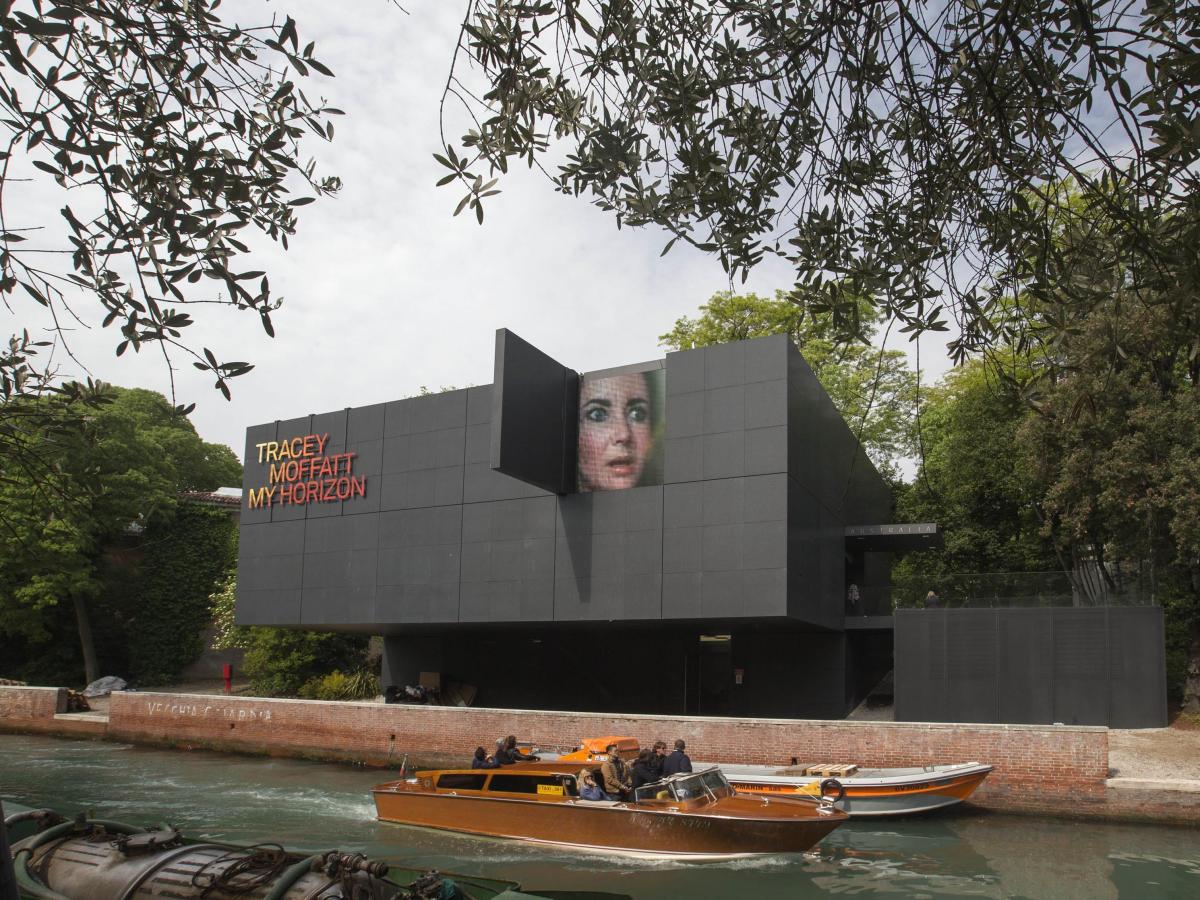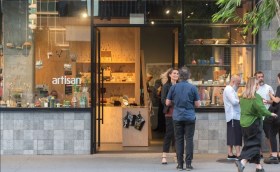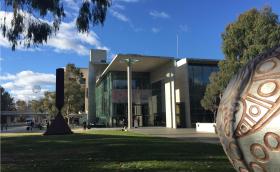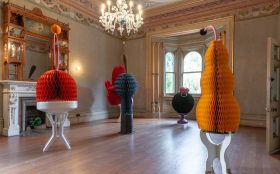Photograph: John Gollings
Today, Tracey Moffatt’s Venice Biennale exhibition will be presented to the world.
The solo exhibition by the Brisbane-born artist, titled MY HORIZON, will be opened to art world punters and paparazzi by renowned Australian filmmaker George Miller, alongside Commissioner Naomi Milgrom AO, Australia Council Chair Rupert Myer AO and the Australian Ambassador to Italy, Greg French.
The exhibition, presented in the Australian Pavilion, sits ‘somewhere between fiction and history’ said its curator, Natalie King.
‘Journeys and arrivals, occupation and dispossession, colonisation and massacres, loss and longing are alluded to in her choreographed cast of characters. MY HORIZON is capacious, open, expansive and personal,’ she explained.
Moffatt has created two new series of large-scale photographs, Body Remembers and Passage, and two new video works, Vigil and The White Ghosts Sailed In, which draw on references as diverse as television news reports, poetry, Surrealist painting, documentary photography, Hollywood cinema and Moffatt’s own memories.
Tracey Moffatt’s work for the Venice Biennale unveiled; ArtsHub YouTube channel; images courtesy the artist, and photographs of the pavilion by John Gollings.
Speaking to the exhibition’s title, Moffatt said: ‘My fictional characters are seen to gaze out to the horizon line, possibly dreaming of escape, or reflecting on their memories. MY HORIZON can be interpreted as wanting to see beyond where one is: to have vision, to project out, to exist in the realm of one’s imagination, or to want to go beyond one’s limitations.
‘There are times in life when we can all see what is “coming over the horizon”, and those are the moments when we either make a move or do nothing and wait for whatever it is to arrive.’
Australian Commissioner Naomi Milgrom added that Moffatt’s ‘dedication, focus, discipline and a ferocious commitment’ has delivered a well-presented result.
Understanding Moffatt’s Venice work:
In a statement, King and Moffatt explain the work: ‘Body Remembers is a suite of 10 free-floating photographs that evoke the lives of generations of women who have undertaken domestic and emotional labour.’
.jpg)
Bedroom, from the Body Remembers series; image courtesy the artist
Staged in a remote and desolate location, the photographs depict a woman, played by Moffatt herself, with up-swept, 1950s-style hair and wearing a black-and-white maid’s dress. She haunts the inside of a rustic house and its rough-hewn surrounds.
‘We don’t know if my maid character projects her life into the future, where the house she works in has become a ruin. Or is it that my maid character returns to the ruin to relive a strong memory, perhaps of someone she knew in the house?’ questioned Moffatt.
With their ochre hues on rag paper, the photographs reference vintage sepia photographs and early Surrealist cinema. These large-scale works also suggest murals or frescoes.
Suspended in time and place, the dream-like, distilled images recall a history that for Moffatt is at once personal and universal. The narrative could also be staged in other countries with abandoned stone ruins such as North Africa, Mexico, the Middle East, Spain or Italy.
.jpg)
Mother and Baby from Passage, image courtesy the artist
Passage is a suite of 12 vivid, large-scale photographs on glossy paper, staged in raking late-afternoon sun or at twilight in a mysterious port. The composition is atmospheric and strongly reminiscent of film noir, while the painterly colour and omnipresent haze achieve a Turner-esque effect.
The cast of characters – a mother, a baby, a policeman with a motorcycle and a slim, sharply dressed, cigarette-smoking character whom Moffatt calls ‘the middleman’ – act out a story of furtive encounters in a deserted port.
‘I wanted the 40s-era, film noir images to read as being “of the past”, but the storyline speaks about what is happening in the world today, with asylum seekers crossing borders,’ explained Moffatt.
‘Passage is a story as old as time itself. People throughout history and across cultures have always escaped across borders to seek new lives,’ she added.
Moffatt alludes to the current global crisis of displacement and its impact on the human condition. We are reminded of mass human movement across borders and terrain: the timeless narrative of forced migration.
A two-minute video, Vigil is the most recent entry in Moffatt’s ongoing series of riffs on cinematic imagery. It is inspired by the profound shock the artist felt at seeing television news coverage of the December 2010 drowning of dozens of asylum seekers, whose boat ran aground in rough seas off the coast of Christmas Island in the Indian Ocean.
Set to a foreboding soundtrack, Vigil juxtaposes two radically different kinds of imagery: news footage of dilapidated boats that overflow with dark-skinned refugees, and movie close-ups of white Hollywood actors – Elizabeth Taylor, Kathleen Turner, Julie Christie, Donald Sutherland – who are shown staring through windows. Moffatt has intensified the blood-like hue of the sea, accentuating the sense of carnage.
Moffatt has spoken of how the misery of migrants and refugees often becomes a spectacle for the television and movie audience, “white people gawking at desperate poor brown people in boats”.
The cut-out graphics of Vigil highlight the crisis of refugees and migrants, but they can also be read, Moffatt said, as “a blatant commentary on ‘race’. There is nothing subtle in the editing and construction of Vigil.”

Frame with film still from The White Ghosts Sailed; courtesy the artist
The White Ghosts Sailed In is also a two-minute-long video newly created by Moffatt for the Australian Pavilion. The artist claims that she recently discovered a fragment of old nitrate film in the vault of a former Aboriginal Mission in the centre of Sydney. The footage, as Moffatt recounts, was recorded by Indigenous people using an early film camera that had been discarded by a member of Captain Cook’s crew.
The film was allegedly taken on 26 January 1788: the day when British colonists of the First Fleet sailed into Sydney Harbour to begin the settlement of Australia.
Included in The White Ghosts Sailed In is a panoramic view of the entrance to Sydney Harbour. The degraded film is layered with “ghosts” and decay reminiscent of old nitrate films. Projected onto the battered planks of a Georgian picture frame, the moving image has a brooding, dark hue. The accompanying soundtrack features the sounds of a British military drumbeat, a howling wind and a baby’s cry.
MY HORIZON is the second art exhibition held at the new Pavilion of Australia, designed by Denton Corker Marshall and managed by the Australia Council for the Arts. It is the only water-facing pavilion to be built in the historic Giardini della Biennale.
MY HORIZON: The Pavilion of Australia, Giardini della Biennale
13 May to 26 November 2017, 10am – 6pm
Vernissage 10 – 12 May.






